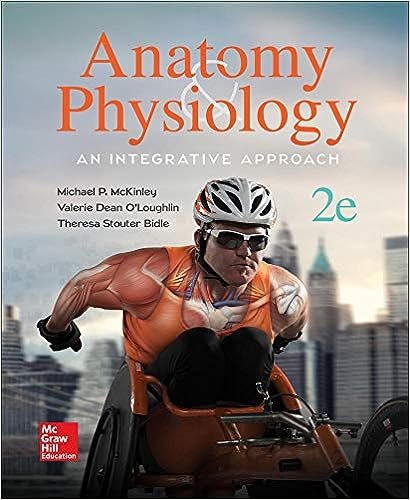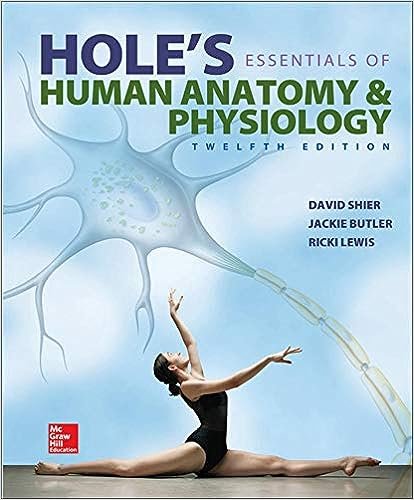Holes Human Anatomy And Physiology 14th Edition by Shier Dr – Test Bank
Nervous System II: Division of the Nervous System
Multiple Choice Questions
- The central nervous system (CNS) consists of
A.spinal and cranial nerves.
B. the brain and spinal cord.
C. the cerebrum and cerebellum.
D. nerves in the upper and lower limbs.
Bloom’s Level: 1. Remember
HAPS Objective: H03.01 List the parts of the nervous system that constitute the central nervous system (CNS) and those that constitute the peripheral nervous system (PNS).
HAPS Topic: Module H02 Organization of the nervous system from both anatomical and functional perspectives.
Learning Outcome: 11.01 Describe the relationship among the brain, brainstem, and spinal cord.
Section: 11.01
Topic: Anatomical and functional organization of the nervous system
- The epidural space contains
A.loose connective tissue, blood vessels, and adipose tissue.
B. dense connective tissue and cartilage.
C. no tissue, that is why it is a space.
D. collagen, elastin, and keratin.
Bloom’s Level: 1. Remember
HAPS Objective: H08.02 Identify the meninges and describe their functional relationship to the brain and cranial bones.
HAPS Topic: Module H02 Organization of the nervous system from both anatomical and functional perspectives.
Learning Outcome: 11.02 Describe the coverings of the brain and spinal cord.
Section: 11.02
Topic: Anatomical and functional organization of the nervous system
Topic: Gross anatomy of the components of the brain
Topic: Protective roles of cranial bones, meninges, and cerebrospinal fluid
- The meninges consist of
A.the brain and spinal cord.
B. the membranes that delineate all of the major brain parts.
C. the pia mater, arachnoid mater, and dura mater.
D. nerve tracts that run up and down the spinal cord.
Bloom’s Level: 1. Remember
HAPS Objective: H08.02 Identify the meninges and describe their functional relationship to the brain and cranial bones.
HAPS Topic: Module H02 Organization of the nervous system from both anatomical and functional perspectives.
HAPS Topic: Module H08 Protective roles of the cranial bones, meninges, and cerebrospinal fluid.
Learning Outcome: 11.02 Describe the coverings of the brain and spinal cord.
Section: 11.02
Topic: Anatomical and functional organization of the nervous system
Topic: Gross anatomy of the components of the brain
- Cerebrospinal fluid is
A.clear and liquid.
B. white and thick.
C. red.
D. yellow in the CNS and clear in the PNS.
Bloom’s Level: 1. Remember
HAPS Objective: H08.03 Describe the functions of cerebrospinal fluid, as well as the details of its production, its circulation within the central nervous system, and its ultimate reabsorption into the bloodstream.
HAPS Topic: Module H08 Protective roles of the cranial bones, meninges, and cerebrospinal fluid.
Learning Outcome: 11.03 Discuss the formation and function of cerebrospinal fluid.
Section: 11.03
Topic: Protective roles of cranial bones, meninges, and cerebrospinal fluid
- In a subdural hematoma resulting from a blow to the head, blood accumulates between the
A.dura mater and skull.
B. dura mater and arachnoid mater.
C. pia mater and brain.
D. arachnoid mater and brain.
Bloom’s Level: 2. Understand
HAPS Objective: H08.02 Identify the meninges and describe their functional relationship to the brain and cranial bones.
HAPS Objective: H16.02 Predict the types of problems that would occur in the body if the nervous system could not maintain homeostasis.
HAPS Topic: Module H08 Protective roles of the cranial bones, meninges, and cerebrospinal fluid.
HAPS Topic: Module H16 Predictions related to homeostatic imbalance, including disease states and disorders.
Learning Outcome: 11.02 Describe the coverings of the brain and spinal cord.
Section: 11.02
Topic: Clinical applications of the nervous system
Topic: Protective roles of cranial bones, meninges, and cerebrospinal fluid
- An inflammation of the meninges called meningitis usually affects the
A.dura mater only.
B. dura mater and arachnoid mater.
C. arachnoid mater and pia mater.
D. pia mater only.
Bloom’s Level: 1. Remember
HAPS Objective: H08.02 Identify the meninges and describe their functional relationship to the brain and cranial bones.
HAPS Objective: H16.02 Predict the types of problems that would occur in the body if the nervous system could not maintain homeostasis.
HAPS Topic: Module H16 Predictions related to homeostatic imbalance, including disease states and disorders.
Learning Outcome: 11.02 Describe the coverings of the brain and spinal cord.
Section: 11.02
Topic: Clinical applications of the nervous system
Topic: Protective roles of cranial bones, meninges, and cerebrospinal fluid
- The ____________ is the thin meninx attached to the surface of the brain, containing many nerves and blood vessels.
A.dura mater
B. arachnoid mater
C. pia mater
D. subdural mater
Bloom’s Level: 1. Remember
HAPS Objective: H08.02 Identify the meninges and describe their functional relationship to the brain and cranial bones.
HAPS Topic: Module H08 Protective roles of the cranial bones, meninges, and cerebrospinal fluid.
Learning Outcome: 11.02 Describe the coverings of the brain and spinal cord.
Section: 11.02
Topic: Protective roles of cranial bones, meninges, and cerebrospinal fluid
- Most cerebrospinal fluid is secreted from the choroid plexuses in the
A.lateral ventricles.
B. third ventricle.
C. fourth ventricle.
D. cerebral aqueduct.
Bloom’s Level: 1. Remember
HAPS Objective: H08.03 Describe the functions of cerebrospinal fluid, as well as the details of its production, its circulation within the central nervous system, and its ultimate reabsorption into the bloodstream.
HAPS Topic: Module H08 Protective roles of the cranial bones, meninges, and cerebrospinal fluid.
Learning Outcome: 11.03 Discuss the formation and function of cerebrospinal fluid.
Section: 11.03
Topic: Protective roles of cranial bones, meninges, and cerebrospinal fluid












Reviews
There are no reviews yet.